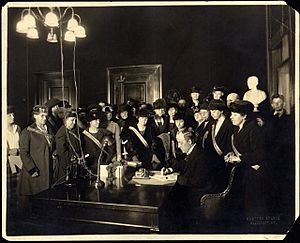Kentucky Equal Rights Association facts for kids
| Founded | 1888 |
|---|---|
| Founder | suffragists from Fayette and Kenton counties, including Laura Clay and Henrietta Chenault |
| Focus | Women's rights, married women's property rights, feminism, school suffrage, temperance, admitting women to higher education, juvenile defense rights, raising the age of consent |
| Location | |
|
Key people
|
Mary Barr Clay, Laura Clay, Madeline McDowell Breckinridge |
The Kentucky Equal Rights Association (KERA) was the first group in Kentucky that worked for women's rights across the whole state. It was started in November 1888. In 1920, KERA changed its name to the Kentucky League of Women Voters. This new group continued to work for women's rights and other important changes.
The idea for KERA came from Lucy Stone, a famous women's rights leader. She spoke in Louisville in 1881. After her visit, a group of women formed the Kentucky Woman Suffrage Association. This was the first group in the South to push for women's right to vote.
Laura Clay was the president of this early group. Her older sister, Mary Barr Clay, also worked hard for women's rights. Mary hosted Susan B. Anthony in Richmond in 1879. Anthony spoke about the need for women to have economic protection. Mary then started the Madison County Equal Rights Association. This was Kentucky's first lasting women's rights group.
Later, Mary B. Clay invited Lucy Stone to stay at her mother's house in Lexington. Stone helped start the Fayette County Equal Suffrage Association. This group later became the Fayette County Equal Rights Association.
In November 1888, Lucy Stone asked Laura Clay to speak at a meeting in Cincinnati. Clay invited all Kentucky women's rights supporters to join her. On November 22, 1888, they created the Kentucky Equal Rights Association (KERA). Delegates from Fayette and Kenton counties joined the four daughters of Cassius M. Clay: Anne, Sally, Mary, and Laura. Even though their father did not support women's voting rights, his daughters led the movement. They fought for women's right to vote, and for legal, educational, and work rights.
KERA decided to work on many reforms, not just voting rights. The first leaders included Laura Clay as president. They chose the slogan: "If ye abide in my word....ye shall know the Truth and the Truth shall make you free." KERA started with only 66 members. They quickly began campaigns, gave lectures, and talked to lawmakers. They wrote petitions, newspaper articles, and pamphlets. They also started new chapters around the state. KERA encouraged women to go to college. They hoped women would achieve full equality in all jobs. In 1890, KERA presented a petition to the Kentucky legislature with 10,000 signatures. By 1895, KERA had 400 members.
Contents
KERA Presidents and Leaders
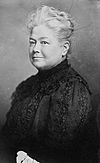 |
Laura Clay (1849–1941) from Lexington and Madison County She was the first president of the Kentucky Woman Suffrage Association in 1881. |
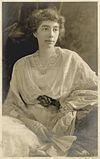 |
Madeline McDowell Breckinridge (1872–1920) from Lexington She was president of KERA from 1912 to 1915. |
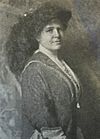 |
Elise Bennett Smith (1871–1964) from Frankfort and Louisville She was president of KERA from 1915 to 1916. |
 |
Christine Bradley South (1879–1957) from Frankfort She was president of KERA from 1916 to 1919. |
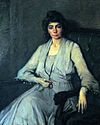 |
Madeline McDowell Breckinridge from Lexington She returned as KERA president from 1919 to 1920. |
KERA's Important Campaigns
Voting Rights and Running for Office
One key plan for women's rights activists was to get partial voting rights first. This would lead to full voting rights later. Kentucky had a law from 1838 that allowed some women to vote on school matters. These were women who owned property and were heads of households in rural areas.
Eugenia B. Farmer of the Kenton County Equal Rights Association saw a chance. She suggested adding school voting rights to new city laws. This was for cities like Lexington, Newport, and Covington. In 1894, the legislature agreed. All women in these three cities could vote in local school board elections. By then, women in fifteen other states had also won partial or full voting rights.
Women voted in these elections from 1895 to 1901. However, in 1902, the legislature took away this partial voting right. This happened despite strong efforts by women's groups to keep it. Finally, after much work by KERA, a new law passed in 1912. This law gave "qualified" women the right to vote and run for office in the new county school system. This law was tested in court and upheld. It protected the right for both Black and white women to vote. In 1913, five white women won elections for school superintendent.
Economic Protection for Women
KERA also worked to change laws about women's money and property rights. In 1894, Governor John Y. Brown signed the Married Woman's Property Act. This law was a big step forward for women. By 1898, KERA also convinced lawmakers that all state asylums should have women doctors. This helped women who were in these institutions.
Women and Higher Education
KERA pushed for women to be allowed into colleges. Because of their efforts, the Kentucky Agricultural and Mechanical College was the first college in Kentucky to admit women in 1880. The Louisville College of Pharmacy started enrolling women in 1890. The Fayette County Equal Rights Association encouraged women to enroll there. They also convinced Transylvania University to open its doors to women in 1889. Soon after, other colleges in central Kentucky also became open to both men and women.
Temperance Movement
Before KERA was formed, Laura Clay and Henrietta Chenault planned a lecture tour. They invited Zerelda G. Wallace of the Women's Christian Temperance Union. She spoke about temperance (reducing alcohol use) and also about women's right to vote. The idea was to show that giving women the right to vote would help achieve prohibition and other social improvements.
Child Labor Laws
KERA worked to protect children, especially those in poverty or facing violence. In 1896, KERA helped pass a law to create reform schools for both girls and boys. By the early 1900s, Kentucky set up juvenile courts. These courts treated children differently in the justice system. KERA also won Kentucky's child labor law. This law helped protect children from working too much. They also helped raise the age of consent from 12 to 16.
Push for the Federal Voting Amendment
The National American Woman Suffrage Association (NAWSA) wanted to show Southern lawmakers how important women's voting rights were. In 1894, Susan B. Anthony and Carrie Chapman Catt started a tour from Lexington, Kentucky. They visited several Kentucky cities and then went to other Southern states. Many Kentucky women leaders also held important roles in national organizations.
By 1910, the idea of women voting became more popular. Large donations helped state and national groups pay for lobbying and publicity. KERA changed its rules in 1910. The president's term became three years, and a president could not be re-elected right away. Laura Clay, who had been president since KERA started, stepped down in 1912. Madeline McDowell Breckinridge, a strong reformer, was elected president until 1915. She also served as a vice-president for NAWSA. On January 14, 1914, Breckinridge and Clay spoke to the Kentucky legislature. They celebrated that women's voting bills were finally moving forward.
Elise Bennett Smith, Laura Clay's niece, became president in 1915. She served for one year and then worked for the national association. Christine Bradley South took over her term. Then, Breckinridge was elected president again in 1919.
Nineteenth Amendment
The U.S. Senate finally approved a federal amendment for women's voting rights on June 4, 1919. After this, Laura Clay left KERA. She believed KERA should have kept working for a state law for presidential voting rights. She thought this was needed to match the Kentucky constitution.
After much debate, the Kentucky General Assembly approved the Nineteenth Amendment. The House voted 72 to 25, and the Senate voted 30 to 8. KERA members were there as Governor Edwin P. Morrow signed the bill on January 6, 1920. Kentucky was the 23rd state to approve the amendment. It was one of only four Southern states to do so. The amendment became law on August 26, 1920.
The Rise of the League of Women Voters
At their 30th yearly meeting in January 1920, KERA members voted. They decided that once the federal amendment was approved, KERA would become the Kentucky League of Women Voters. This change officially happened on December 15, 1920.
See also


